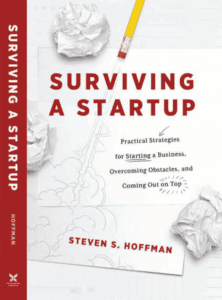Founder Space CEO Steven Hoffman shares strategies on how to survive the competitive business world and get your sweat equity startup to hit the ground running.
Startups are the future. But not every startup idea survives. In fact, 90% of them fail. How do sweat equity startups hit the ground running in this extremely risky environment? In this episode, Steven Hoffman, also known as Captain Hoff, discusses how to survive the competitive market. Steven is the CEO of Founder Space, one of the world’s leading startup accelerators. He joins host Meny Hoffman to share practical strategies to help you overcome the many obstacles that come with starting a business. Steven maps out the process from developing an idea to forming a team. Tune in as he shares invaluable insights to help you grow from his latest book, Surviving a Startup.
Listen to the podcast here:
Download the audio file here.
When Sweat Equity Start-Ups Hit the Ground Running–with Steven Hoffman
My guest is Steve Hoffman. Steve, or Captain Hoff as he is called in Silicon Valley, is the Captain and CEO of Founders Space, one of the world’s leading startup accelerators that’s ranked as Top 10 Incubator in Inc Magazine, Forbes, and Entrepreneur Magazine. Steve is a venture investor and serial entrepreneur who spends most of his time traveling the world and working with entrepreneurs, investors, and governments to promote innovation and growth.
He is an author of several award-winning books, including Make Elephants Fly and Surviving A Startup. Throughout his career, Steve has founded many highly successful organizations and venture-backed startups in the entertainment and gaming industries. In our interview, Steven and I discussed the mindset of a startup, if you want to set yourself up for success and how you need to set yourself up properly.
—
Captain Hoff, thank you for joining me on the show. For our readers, we have two firsts, the first Captain and another Hoffman on the show as well, so it is Hoffman interviewing Hoffman.
It is a real treat for me too. I love to meet other Hoffman.
We have a lot to cover. There are a lot of your experiences that we could share with our readers. We had a chance to chat briefly and we were connected by an acquaintance, but before we start, as we do with every show, tell us a little bit about your past history and what got you where you are. We have some tough questions to get into.
I have been in the startup industry doing business my whole life. I have done three venture-funded startups and two bootstrap startups. I founded a startup incubator and accelerator called Founders Space, growing globally over the past few decades. We have over 50 partners in 22 countries and are still expanding. I’m the author of several books. Make Elephants Fly is a book all about the process of radical innovation, how startups innovate, and the top entrepreneurs in the world, and Surviving A Startup, which was published by Harper Collins, is my new book. That is about everything entrepreneurs need to know to overcome big obstacles, raise capital, and scale their businesses.
Readers, here’s a treat. By the end of the show, you are going to know how to make elephants fly.

They will, hopefully. An elephant is supposed to be your big dream that seems impossible to get off the ground. How do you make it fly?
Let’s get into the basics and crack up that myth out there. When people hear the word startup, they are looking at a SaaS business. “I’m going to build the next Facebook, the next Instagram because I’m going to have this rich exit. I’m going to sell my company,” and so on. What is the premise of a startup? How do you see it in the startup that you work with on a regular basis?
For me, there are all types of startups. There are family business startups, small startups, startups that will grow to a mid-size but never go beyond that, and startups that I work with. Those are venture fundable startups. They have very specific criteria. You literally have to start a company that is going to grow exponentially over the next several years. That is what venture capital is looking for, so those are the startups we focus on. They can be technology-based. A lot of them use new technologies, but not necessarily. You don’t have to have a technology to scale like that although, it does make it easier.
We live in a world that technology could always be a substitute. Different parts of a company that may be years ago were done with labor and in a way that is not so scalable. You could use technology in your startup versus the product as technology.
For most startups, technology opens a new door and an opportunity to do something different or much better than it has been done before. The technology isn’t what you are selling. People don’t buy technology. They buy solutions and your customers don’t care what technology you use. They care what you can do for them. How can you make their business better? How can you make their lives better? That is what we look for as venture capitalists.
I want to get into the mindset of a startup because it is very important. Although a lot of our readers and people have already started the company, I always say the mindset of a startup never should go away. We live in such a fast economy that you constantly have to look at what’s happening in my industry. How can we reinvent my industry? I’m not talking about that shiny object syndrome that you always have to change your business model, but you have to have that mindset because there are better ways of doing it about technology and so on. I want to speak about a specific question I want to dive into, which is something that I have probably shared with entrepreneurs a thousand times, which is not every business is an idea, and not every idea is a business.
Sometimes, you speak with the entrepreneurs, and they want to create this new idea, which is something that has never existed. Just to mimic and piggyback on what you said about a solution. If you sit with them, why should somebody want to pay for this? I don’t know. It is cool. Why shouldn’t you have this technology or this idea, feature, or whatever it is? When you look at a startup, you have to sit with an entrepreneur and dissect the business. How much of that is the business? How is it going to be run? How much is the idea of what problem it is solving?
I work with entrepreneurs and do something very different, especially at the early stage than most people think of. Most people say, “Start with an idea. I’m not going to start my company until I have that brilliant insight or idea that is going to change the world.” Honestly, what’s in the entrepreneur’s head at the beginning is totally wrong or it is partially right. They don’t know because they haven’t taken it out into the world, gathered feedback and real data.
[bctt tweet=”People don’t buy technology. They buy solutions. ” username=””]
For entrepreneurs, I tell them, “Don’t worry about the idea at the beginning.” Doing a startup is a process of discovery. It is the process at the beginning of discovering what the right idea is. What are all the elements you, as an entrepreneur, need to put together to get this business going and prove it out? When you are beginning your company, pick a direction or an area that you are interested in exploring.
It is much better this way. A lot of times, when you pick an idea, you lock yourself into that idea. You convince yourself because you have to. You are taking a big risk. You may be quitting your day job and borrowing money. You convince yourself that this idea is great and as soon as you convince yourself that something is great, most people have confirmation bias. They want to only look at the data that reinforces that belief that this is great.
They get going, but they are usually not going on the right path, which can lead to failure. If you say to yourself, “I don’t care about having one idea. I’m going to have a lot of ideas, but I’m interested in this area. I’m interested in how technology and the fishing industry can work together to increase yields, decrease other environmental problems, and depletion of fishing.”
Let’s say that is the area you want to work in. You don’t have to have a specific idea, and then you start to go deep in that. You figure out what are all the problems. What do people need? What are real solutions and what can technology do? Along the way, you may come up with dozens of ideas, which is great, and you start to test each one out. That is what I like entrepreneurs to do.
We sum it up. Usually, version one is always better than version none. Meaning to say you got to get in front of the people about the problem you are solving in that audience in order to get feedback, especially in technology. You think you are building out a task management system, then all of a sudden, your customers are using it for a totally different used case. A future product, the releases, and stuff like that is shifting because of that versus you are so in your box focusing on one thing that you originally invented or thought you are going to be working towards, and suddenly, the market doesn’t even need that.
This happens more often than people realize. We always look at the final company. When Google started, it didn’t start with the right idea. The Founders of Google, Larry Page and Sergey Brin thought they were building a nonprofit because they thought they were building a search engine for academic research papers, which is a very small market. It is for professors.
They discovered, “No, we could apply this to almost any search on the internet.” It is the same thing with Groupon. When they started, it was a site for doing social good, but then their users in their site started to use the features to get discounts on products and on and on. If you look at all these different startups, they started with one idea and ended up with a totally different idea.

I want to ask you a little bit of a different question when it comes to those startups, the business and the problem they are solving, and the solution they have versus the people, and obviously, it starts with a leader. How much are the person and the people running it or starting it contribute to the success of a startup?
I’m an investor. I invest in lots of companies, but I also mentor lots of entrepreneurs all around the world, hundreds of them. When I work with the teams, I can see the difference. I see some teams that are not a very good or right team, but they have a great idea. Almost always, that team fails. They bungle the execution and cannot get all the pieces going. However, a lot of times, I work with good people who don’t have a great idea at the beginning. They are fumbling around and don’t know what to do, but they are smart, dedicated, and thoughtful. They have the right skillsets. They usually figure it out. They keep iterating and trying, and eventually, they hit on something, and they go. I will always bet on the right people over the right idea or product.
Let’s get into the structure of a startup or a successful company. Obviously, you are coming from an investor’s perspective and we will talk soon about the different ways people could get when they are due for raising money and getting different types of money available for startups. How do you set yourself up?
When push comes to shove, you want to go out for investment that the investors say, “You are a hobby, not a business. You are not investible.” Those types of lines come from those sharks. Give us some practical advice on how a person could prepare themselves when they are ready then what options are out there.
We like to say in Silicon Valley, “You are a lifestyle business,” which means you can make some money on the side, improve your lifestyle, but you are not going to become a big business. That happens all the time. The majority of ideas people have are small or medium-sized at best. They are lucky to get to medium size. They are not these big scalable things. That is why these companies that took off unicorns were so much because they are hard to come up with. They are not easy.
The criteria is relatively simple when you are analyzing your business. You have to look at how many customers are out there. How big is the market? What is my position in the market? Are there lots of competitors already filling the market? Am I literally like them, but maybe with a few features or other things different, but nothing fundamentally different? Is there an ability for me to offer a core value to these customers that they are not getting already from the marketplace?
These elements define whether a startup is going to be a lifestyle or a big business. The other thing is scalability. How can I scale this? Some businesses are difficult to scale because they require a lot of people and time, like consulting businesses. There are big consulting companies, but they are few and far between.
Most consultants are solo entrepreneurs or they work with a couple of other consultants. They are very difficult to scale. As a venture investor, I’m not going to bet on those. I’m going to bet on something easy to scale. Meaning you can build a product, take it to the customer, and basically replicate that over and over again with other customers.
[bctt tweet=”Always bet on the right people over the right idea or product. ” username=””]
This is where technology startups shine. If you have an internet-based business, literally you can build it once and then deploy it everywhere on the globe to all sorts of different customers. When we were looking at a business, you have to look at what’s in the entrepreneur’s head, who they are, and these basic criteria for how big that business can become.
At which point do you think a business is ready to take out an investment? Obviously, they are the bootstrapped companies that are trying to do it. Ultimately, they are doing it on a slower phase but reaching higher success. In technology, we see it a lot, but I want to try to speak outside of technology and where technology is. You need infrastructure, marketing, going out there and gaining market share. Let’s speak about the product-based or a service-based business, where you want to scale it and need outside capital. At which point do you think a business is ready for capital?
A mistake a lot of entrepreneurs make is they try to go for capital too early. Especially when you are talking to venture investors, they want to see tangible proof that you have something. They may be called venture capitalists, but honestly, they aren’t that adventurous. Nobody wants to lose their money. In order to hook one of these investors, you have to show them something that they can extrapolate from and say, “There is something real here.”
These people figured out something. They are not just talking because anybody can talk. We meet a lot of people who can put on a great talk, but if you are a smart investor and you have been in the space for a while, you are literally going to look very closely at the business. With companies, you can raise Angel funding with a business plan and a great idea, but a small amounts of Angel funding like $100,000, $150,000, or so, you can do that. Angels will often take a risk.
When you get into real investors who are going to put in real money and experience, what they want to see is validation from your customer. That means some proof. Are your customers ready to place orders? Have they placed any orders? That is great. How many of these customers are placing orders, or have you talked to? The more, the better.
If you can’t get your customers to place an order or commit to an order, can you get them to give you feedback or try the product? Can they write a letter of intent at least that they are going to do it? A lot of times, I tell entrepreneurs, “It depends what your product is.” If it is a B2B product, it is easy. If you are going B2B, go to those businesses and talk to them.
Even if you have to bring a video camera and record them as you are doing your pitch, their feedback, and what they are thinking, do that because that is proof you can show investors if the businesses are super excited, like, “I got to have this. When is it ready? Get it to me.” Capture that. If it is a consumer product, you have to let them build an early prototype and put it out there. If you can’t afford to do that, there are sites like Kickstarter, Indiegogo, and crowdfunding sites. You can put it up there and create a great video.

A lot of startups like Oculus went through the roof, putting out their VR video, raising tens of millions of dollars, and then getting sold before they even launched their product for $3 billion to Facebook. It is all on a video. They got proof from the community out there, the excitement, the media, and everything else that this was potentially something for the future. That is what I tell you. Get out there. Get as much proof from as many sources as possible. That is what investors want to see. They don’t want to see just the shiny business plan.
As far as the types of VCs or deals, obviously, it depends a lot on what is happening on the ground. I know that there are different funding rounds, pre-funding rounds, and convertible notes. As a startup, what do you usually recommend for business owners? If they could push it as far as they could go and use it, what would be the best setup for a startup?
You have to be, as an entrepreneur, very careful. It is risky. Over 90% of startups fail. That is a fact out there. I write a lot about this. When you go to your family and friends to borrow money, which is what most entrepreneurs have to do because they don’t have enough money, be cognizant of what you are asking them because you are asking them to take a risk were 90% chance they are not going to get their money back.
If it is your parents and they don’t care and love you no matter what, you could take their money but if it is Uncle Joe or your best friend and you lose their money, that relationship may never be the same. More often than not, it is not the same. I tell entrepreneurs, “At the very beginning if it is your first startup and you are probably going to fail, do not pick an idea that you need a lot of money for. Pick an idea that you can do with sweat equity like you can do it with your time and other people’s time, people that you can get to commit to joining you because they believe in you, the direction you are headed and want to do a startup.”
Those are the best startups. If you are doing anything else, you are gambling a lot. You are gambling with your own money, maybe your life savings, and you do not want to risk the relationships of the people you care about. If your company doesn’t work out, that is when those relationships are strained, but that is when you need your family and friends the most. You need their support.” I have done a lot of startups. I never took a penny from family and friends. I know a lot of people do. We always read the success stories. We don’t read the non-success stories. Nobody wants to talk about that their relatives won’t speak to them anymore, their friends have disowned them and all this stuff because they lost all their money.
Everybody thinks they are going to get rich. These are internet startups. People read about it and don’t have a realistic expectation that they are going to fail. They think it is going to be the next Google and Facebook, and you are going to make them rich. When you end up losing all their money, they can’t help but feel like you trick them or something is wrong. You don’t want to be in that position.
If you can’t raise money from an experienced Angel investor who knows what they are doing and the risks, maybe you shouldn’t be raising money. You shift your idea to do something that you can do yourself. You can get a startup and a lot of great businesses are started by people putting in sweat equity and a little bit of money. A lot of them are started by people who have full-time or part-time jobs. They haven’t totally left their jobs. They are doing this on the side, keep iterating, and try new things. That is a much safer way to do it and a healthier way to approach starting a business.
[bctt tweet=”A lot of great businesses are started by people just putting in sweat equity and a little bit of money.” username=””]
I want to go back to a couple of points. For our readers, in general, a lot of times, I see it, and probably you have seen it as well. Let’s say the founder of the startup is maybe more technical and much more into tech-savvy and technology, or whatever it is. They go to a family member with zero clue on what technology is all about, only the excitement of technology. They don’t even know where the money is going and are not even asking the right questions because they feel that they don’t even have the bandwidth to understand what the person is doing.
That is for sure a no-no. At least when you take somebody’s money, make sure they understand the risk, the market, where the project could go wrong and might not run out of money before we get to the next step and take back your money. At a minimum, there should be that understanding because that could also help out a lot. When it comes to pushing comes to shove, I need more money. I thought I had put in my $100,000, and that is about it. We were off to the races.
I like to tell entrepreneurs that when you are raising money from family and friends, tell them, “Ninety percent of startups fail. You are not getting your money back. If you want to give me your money and you are going to Vegas right now, giving me your money and putting it down on a roulette wheel with a 90% chance, you won’t get a payoff. 10% chance you will get a payoff and maybe a 1% chance you will get super incredible riches. This is a slot machine. Don’t expect more.” They understand that. Going into it, you will be much better off if things don’t work out.
Let’s talk about it. Why 90%?
Ninety percent is a number derived. It is out there in a lot of different validated sources, but it is derived from the idea stage. A lot of people have ideas early on. They try something, raise a little money, put in the time, and then walk away from it. You don’t hear about them, but they fail all the time. The reason it is 90% is that doing a business is hard for a lot of reasons. Entrepreneurs make a lot of mistakes. Being an entrepreneur and having gone through this myself, I know. I did companies that were successful. My first company was successful. It was a bootstrap company. I produced all these gains that I coded myself. It did well.
My second company was successful at first, but then things that are totally out of control come along and can slam you. The dot-com bubble burst at that time and took down me and a lot of other companies that may have done fine if that huge implosion hadn’t happened. These market changes are things that are totally out of your control that you can’t foresee. Startups are fragile. It doesn’t take a lot to kill a startup. Honestly, when you are running on fumes, have little money and few resources, one hiccup along the way. For a larger company, they are like, “This project didn’t work out,” but for a startup, you have to start over. That is why it is the 90% number.
Talk to me about that. Obviously, a lot of businesses, some of the startups are fragile. We haven’t even another layer, which a lot of startups into the technology space are built on other platforms, such as the best widget for Shopify, or Salesforce add-on, or whatever it is or technology that is being used this way or that way. All of a sudden, that goes away, or Amazon buys off and offers now that service immediately, this whole business goes away. You mentioned the dot-com bubble. What would that do for your company? If you could share some more insights on that.

My personal experience of living through the dot-com bubble, we were doing great. We had this company called Spiderdance. We had a huge number of media partners. We were partnered with NBC, Time Warner, Viacom, Turner Broadcasting, Game Show Network, and all these big companies were using our products and services. It is literally paying us money. We were growing our business, number one in the space, had a buyout offer from a public company. We could have sold, but our investor is like, “You are crazy to sell now. You guys are number one. Keep going.”
Literally, the floor dropped out from under us. The market went away. When the dot-com bubble crashed, all the big media companies that were our customers literally looked at their spending because their advertising revenue plummeted at the same time. They cut out everything that wasn’t essential, and that meant all experimental projects. We were doing an interactive TV platform like you would run a game show online. It would be on air at the same time and you play along synchronously.
This is nice to have, but it is not a necessity. NBC was one of our biggest customers. We were doing their show, Weakest Link. NBCI group at the time, when we signed up with them, had 250 people on board working. After the dot-com bubble burst, they were three people running the whole NBCI at that time. They decimated it.
They looked at us as a third-party vendor providing a service. They are like, “You can do this and sell the advertising.” They were selling the advertising for us and paying us. They are like, “We were not going to pay you anything. You sell the advertising.” This interactive advertising, which was a new thing at that time. We were like, “We were not equipped to do that.”
The revenue went to zero literally overnight. What can you do? We had debts out and loans to fuel our company and venture debt. We couldn’t sustain it. We didn’t go bankrupt. I cut a deal with our creditors and gave them our technology in exchange for giving our debt so that we could quietly close our doors. That was the best solution I could come up with. They were also bankrupt because they had lent too much money to too many startups. It is a blood bath at that time.
I want to speak a bit about the valuation. Obviously, when you speak about investments and we see this insane evaluation coming out of VCs in this day and age and bidding war. How much of it is real, which means it makes sense? How much of it is inflated, making sure that nobody else buys your company?
Valuation now, especially in hotbeds like Silicon Valley, Israel, New York, Beijing, places like that, are through the roof. If a startup is hot, its valuations are sky-high. I’m an Angel investor. I work with lots of other Angel investors to help early-stage startups. We were looking at the numbers and at this valuation coming in. Even if the company is successful, we were only going to get a 4X return. Is that worth the risk for an early-stage unproven startup?
[bctt tweet=”Investors love recurring revenue. It is the Holy Grail.” username=””]
Often, the answer is no. It is not worth the risk. You are seeing that there is a bit of a pullback on the public markets because valuations for tech companies have been so high. We have been living through a big boom, and there are always cycles and ups and downs. Still, in Silicon Valley, if you have a startup and you are hot, it is binary. If you are in a tract, you are hot, and people are talking about you, you can literally command your valuation.
The valuations for early-stage startups are what used to be a $5 million valuation. It is now a $20 million valuation. If that gives you any idea, $5 million pre-money is now $20 million pre-money. It is four times higher than the traditional average. You have to be very selective as an investor. It is a great time if you are a hot startup. If you are not a hot startup, it is still tough. Don’t fool yourself. It is never easy if you are not hot.
There is always something, but valuations are dictated more than anything by the market itself. It is literally how many investors and capital are there out there? Interest rates are near zero. The Feds have pushed them down. There is a ton of liquidity and capital in the market. It is chasing returns. It is not just driving up startups. It has been driving up stocks and the whole spec trend that is imploded a little, but still there. Bitcoin and these cryptocurrencies has been a little crazy. To make this long-term sustainable, we were probably going to have to get back to a more normal number.
I know that in the SaaS business, there is a recurring revenue component to a business that brings up the valuation. How much would you suggest to a startup or somebody who works with you as mentorship to try to build in that recurring revenue model even if the service business? How much does it play out in the real market when you go out for funding?
Investors like myself love recurring revenue. It is the holy grail. Let me tell you why. SaaS companies have been hot for a long time. They are not a fad. They have been around and do well. Especially when you have business customers, it is a B2B marketplace, and they are paying you, or even B2C if you have a SaaS that can command us. A lot of them are blended B2B and B2C. The idea is you can pretty much predict the revenue. I said and I’ll say it again, venture capitalists are not that adventurous.
When they can predict the revenue, they can look out and say, “We know this company is earning this much. These people have bought in annual or monthly subscription plans. We can estimate out what they will be paying. We were looking at the current growth rate and the customer acquisition costs. We can determine. If we give you money, you can go out and acquire customers, and their lifetime value will be significantly more than you are spending to acquire them. This is a good risk. In fact, it is a no-brainer.”
If there is a big market out there, they will have a lot of untapped customers, and you have already shown that you are offering new value to these customers. SaaS is a beautiful model because it is so easy to analyze, whereas a lot of other businesses are much harder to decipher. You are launching a new technology, you are a consumer base, or we don’t know if it will take off. Even when a SaaS product is small, if it is got traction, customers are paying, you can start to extrapolate out and make very accurate predictions. That is why we love recurring revenue.

For our readers, I will speak about this point, which is almost every type of business you could figure out a model, which could be recurring revenue. Even if you are in the service business, you could figure out a way how you bill your clients, which is recurring. They get some better rate, service or already on the schedule. They don’t have to call you and say, “I’m booked up for the month or whatever you could do.” Obviously, if you could find a recurring service, you are delivering the service and getting paid, that is great. It is not dependent on technology in this day and age. It’s a very important part, which is the lifetime value.
If you speak to an investor or even yourself in your leadership meetings, ask yourself, what is the lifetime value of our clients? Many people are getting the next client and not maximizing the lifetime value. It is not about the number of clients you have. It is about how high is the lifetime value, either in timing or value as far as dollars and cents. You could also predict if we have X amount of clients, we know the lifetime value and we also know how much to spend on marketing.
We are a marketing agency. Sometimes, we ask, “How much can we spend on this campaign?” He says, “I don’t know. I want to get clients. What is the lifetime value of the client so we know how much we can spend? If we only get five clients from this campaign, you should be good but sometimes, the expectation of a marketing campaign is I need to have hundreds of clients to pay off because it cost me $100,000.”
If you know the lifetime value of a client is $60,000, $70,000, or $80,000 in the span of three years, whatever the services you offer, all of a sudden, we could have way less clients come in from their marketing campaign and still turn a profit. These are two very important points for our readers that you mentioned, the lifetime value and ultimately the recurring revenue.
I want to ask you one more question on this topic. We call it the chicken or the egg. Here, we speak about the entrepreneur and the people. You are betting on the people but on the other hand, when you are investing money, you want to invest in a business, which should be bigger than the person running it. It should be sustainable even the person quits tomorrow. How much do you want the person to be involved in the company? How much do you want the company should have processes to be able to run? Who is the person at the top?
It is important to be able to invest in a company where if somebody gets sick, has a family issue, or quits, the whole company doesn’t fall apart. They aren’t the linchpin keeping it all together, and then it disintegrates. As an investor, this is a big concern of mine, but we also look for CEOs, especially to have some magic to them, charisma, and the ability to communicate their message and vision. What is Tesla or SpaceX without Elon Musk?
Elon Musk has driven those companies. What is Facebook without Mark Zuckerberg? What is Microsoft without Bill Gates? These people have something special about them. There is always a push and a pull between that. We don’t want somebody who’s bland and replaceable. We do want that special person who can add a lot of value to the company. We would always gravitate towards that.
[bctt tweet=”Put 80% of your time upfront into just finding the people. ” username=””]
At the same time, no single person has built a billion-dollar company. They may take all the credit for it. Elon Musk may take all the credit for it, but honestly, he didn’t find Tesla. He was an investor who took it over and took it to new heights. Granted, he did an amazing job, but he didn’t start that company. Not one person doesn’t do this. The quality of an organization is based on the processes they put in place and, importantly, the people they put in place from the very beginning. As an entrepreneur, I look at early-stage startups, and they are not going to have a lot of processes.
They are figuring things out. I can judge the quality of the CEO based on the people that the CEO is surrounded by. If the CEO is surrounded by amazing people, people could be working with Microsoft, Google, or any other big company earning a six-figure salary, yet these people have quit those jobs to join this startup and make it a success. That is evidence to me that this person has something. They know how to attract people, especially when they don’t have a lot of money. It is hard.
They must have some magic to them, but they also have the organizational wits to bring in and make these people comfortable because you need a top management team. The CEO is just going to be the figurehead at the top of the pyramid. You need all those people under the pyramid. You need to see that from the very beginning.
This is something interesting. I often tell entrepreneurs, “When you begin your process of building your company, don’t spend all your time trying to think of that great idea. Don’t spend all your time trying to build the prototype or build the early product. Don’t even spend time going after customers right away. The first thing I want you to do is thinking about the other people you want to work with. What space are you in? Who do you need to build a business together? Can you bring those people on board? Once you get those people, everything else becomes easier.”
Engaging with the customers, building the prototypes, going out, and raising capital becomes easier. Put 80% of your time upfront into finding the people. It is a lot of work. Finding mediocre people is fairly easy but finding exceptional people is incredibly hard. You will have to put a lot of time into those who are passionate about it, willing to commit to it like you, see the opportunity, and bring them in early. If you can do that, your chances of success go up so much. To your question, put processes in place. You, as the CEO, don’t have to put them all in place.
What you have to do is go to your team. If you have an exceptional team and say, “What can we do to make this company function well? What are the processes we need to put in place? If I’m out traveling, you don’t need to come to me. You guys can run the show.” When you do this, that is a point when you are building a great organization.
Let’s speak a little bit about the new book, Surviving A Startup. Obviously, some of the parts of the book are probably covered in this episode already, but I want to ask you, at which point do you graduate the word startup, you are no more a startup, and you cannot use the terminology anymore for your company?

It is funny. Everybody calls themselves startups until they either get acquired or go public. Literally, it doesn’t matter. They are pre-IPO and still a startup as long as they are in the private markets. The term is very flexible. I didn’t write the book for companies that are already unicorns. If you are running a unicorn, you probably don’t need my book. You are probably on your way.
If you aren’t running a unicorn anywhere up to becoming a unicorn, those are the startups that are still at risk and need help understanding what other entrepreneurs have done to build their businesses and get around all these. Every time I run a startup and I work with entrepreneurs, every single day, there is something that is urgent that you have to do. If you don’t do it, everything is at stake. When you are in that mode, surviving a startup is important because you have to deal with those on multiple levels.
Where can people find out more about the book, yourself, and everything you do?
If anybody wants to reach me for any reason or they want to submit a business plan to Founders Space, contact me about some opportunity or check out the books, go to FoundersSpace.com. I’m on every social network, Facebook, Twitter, Instagram, and YouTube.
Let’s close with four Rapid-fire questions. Number one, a book that changes your life?
Many books have changed my life. I love the book by the founder of Nike, Phil Knight, Shoe Dog. Read Shoe Dog. It is very inspiring.
Number two, a piece of advice you got that you never forget?
Push for a no. When I was doing my first startup, my sales mentor said, “When you go to customers, don’t try to get them to say yes. Try to get them to say no. Most customers aren’t going to buy your product. If you can figure out why they aren’t buying your product, you may be able to get them to a yes. If you can’t figure out why they aren’t buying your product, you don’t have anything. You are just chasing them.”
Number three, anything you wish you could go back and do differently?

There are so many things I wish I could do differently. When YouTube approached one of my companies early on about buying it and didn’t sell wasn’t my decision. I didn’t have that relationship, but I wish we had said yes.
The last and final question, what is still on your bucket list to achieve?
I have so much I want to achieve, but the big thing I want to achieve when the pandemic ends is traveling and going around the world. I gave up my home. I’m kicking the bucket right now. Hopefully, not dying, but I am literally traveling to a new city every other week, meeting with entrepreneurs and helping them grow their business in person. I want to do this all over the world in the next year or two.
Captain Steve, thank you so much for joining us. I know your time is valuable. That is why, in the name of our readers, we will forever be grateful for sharing some of your time with us.
Thank you. It has been a pleasure.
It is my pleasure as well.
Important Links:
- Founders Space
- Make Elephants Fly
- Surviving A Startup
- Groupon
- Kickstarter
- Indiegogo
- Oculus
- Spiderdance
- Facebook – Founders Space
- Twitter – Founders Space
- Instagram – Founders Space
- YouTube – Founders Space
- Shoe Dog
- https://www.LinkedIn.com/in/foundersspace/
About Steven Hoffman
 Steve Hoffman, or Captain Hoff as he’s called in Silicon Valley, is the Captain & CEO of Founders Space, one of the world’s leading startup accelerators. He’s also a venture investor, serial entrepreneur, and author of several award-winning books. These include “Make Elephants Fly” (published by Hachette) and “Surviving a Startup” (published by HarperCollins).
Steve Hoffman, or Captain Hoff as he’s called in Silicon Valley, is the Captain & CEO of Founders Space, one of the world’s leading startup accelerators. He’s also a venture investor, serial entrepreneur, and author of several award-winning books. These include “Make Elephants Fly” (published by Hachette) and “Surviving a Startup” (published by HarperCollins).
Hoffman was founder and Chairman of the Producers Guild Silicon Valley Chapter, served on the Board of Governors of the New Media Council, and was a founding member of the Academy of Television’s Interactive Media Group.
While in Hollywood, Hoffman worked as a TV development executive at Fries Entertainment, known for producing over a hundred TV shows, acquired by MGM. He went on to pioneer interactive television with his venture-funded startup Spiderdance, which produced interactive TV shows with NBC, MTV, Turner, Warner Brothers, History Channel, Game Show Network, and others.
In Silicon Valley, Hoffman founded two more venture-backed startups, in the areas of games and entertainment, and worked as Mobile Studio Head for Infospace, with such hit mobile games as Tetris, Wheel of Fortune, Tomb Raider, Thief, Hitman, Skee-Ball, and X-Files.








